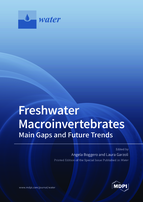Freshwater Macroinvertebrates: Main Gaps and Future Trends
A special issue of Water (ISSN 2073-4441). This special issue belongs to the section "Biodiversity and Functionality of Aquatic Ecosystems".
Deadline for manuscript submissions: closed (30 November 2020) | Viewed by 30292
Special Issue Editors
Interests: biodiversity; water management; chironomids; freshwater ecology; macroinvertebrates; ecological indicators
Special Issue Information
Dear Colleagues,
Freshwater macroinvertebrates play a crucial role linking sediments and their processes to the food web. Indeed, environmental modifications (e.g., nitrogen deposition, salinity, and temperature increase), pollution (e.g., pesticides and heavy metals), and introduction of alien species are the main drivers of changes that are affecting their communities.
This Special Issue aims to present the past and present knowledge on freshwater macroinvertebrates to understand their role as providers of ecosystem services, to highlight the effects of global changes on their community (in the short and long term), and to underline major gaps in their study.
A special emphasis will be dedicated to pristine high-altitude streams and lakes, wetlands, lowland rivers, and ponds and to the usefulness of macroinvertebrates as biological indicators of environmental change for the assessment of water status.
The link between morphological taxonomy and DNA barcoding, metabarcoding, and eDNA will also be emphasized.
A focus will be dedicated to biogeography and the importance of shared, open access datasets accessible to researchers, stakeholders, and water managers in light of the undeniable growing importance of the link between research and policy.
Finally, in order to tackle the currently unsustainable use of freshwater natural capital, we welcome ideas and expert opinions on the development of future research linked to national and international regulations.
Dr. Angela Boggero
Dr. Laura Garzoli
Guest Editors
Manuscript Submission Information
Manuscripts should be submitted online at www.mdpi.com by registering and logging in to this website. Once you are registered, click here to go to the submission form. Manuscripts can be submitted until the deadline. All submissions that pass pre-check are peer-reviewed. Accepted papers will be published continuously in the journal (as soon as accepted) and will be listed together on the special issue website. Research articles, review articles as well as short communications are invited. For planned papers, a title and short abstract (about 100 words) can be sent to the Editorial Office for announcement on this website.
Submitted manuscripts should not have been published previously, nor be under consideration for publication elsewhere (except conference proceedings papers). All manuscripts are thoroughly refereed through a single-blind peer-review process. A guide for authors and other relevant information for submission of manuscripts is available on the Instructions for Authors page. Water is an international peer-reviewed open access semimonthly journal published by MDPI.
Please visit the Instructions for Authors page before submitting a manuscript. The Article Processing Charge (APC) for publication in this open access journal is 2600 CHF (Swiss Francs). Submitted papers should be well formatted and use good English. Authors may use MDPI's English editing service prior to publication or during author revisions.
Keywords
- bioindication
- monitoring
- ecotoxicology
- environmental quality
- ecosystem services
- molecular ecology
- taxonomy
- biogeography
- alien species
- climate change







